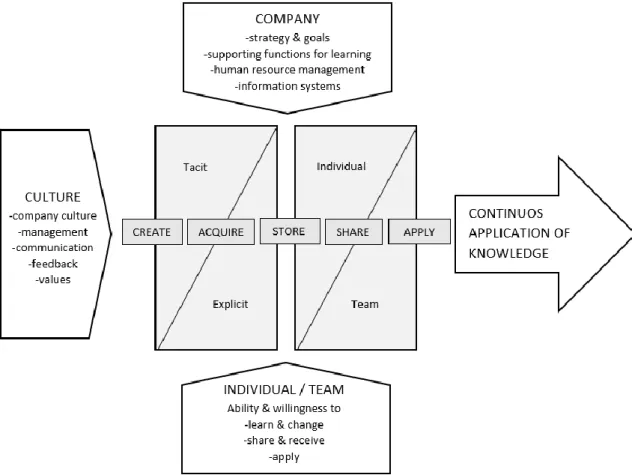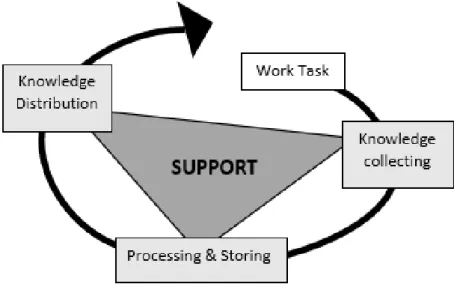The results of this study reveal the underlying causes that cause knowledge management and knowledge support problems in the target organization. How information and knowledge is handled and how it is supported has not been followed.
Background and introduction of Airline X OCC
The Duty Operations Manager also oversees the day-to-day operations of the OCC during the shift. Many of the tasks, both in the operations control and crew control functions, are highly regulated by the authorities.
Research problem and research questions
The set of tools for knowledge management and support in the department is extensive, but since the information is scattered and sometimes also inconsistent, it sometimes seems to confuse rather than support decision-making.
Objective and scope
However, knowledge management as a whole is such a broad concept that the scope of this study is limited to knowledge and information in the operating environment. This study also only focuses on knowledge management and support for the operative work and does not consider knowledge management for the planning work, even though these functions fall under the same OPAC department at Airline X.
Structure
The basic nature of the operational controller job and the planning job are significantly different from each other, and therefore the knowledge and support needs are quite different, and difficult to consider in the same study. Reflections on the research process and the credibility of the research are also included in this last chapter.
The concept of knowledge
The tacit knowledge is formulated and made tangible by defining, describing and articulating it as. In the combination phase, new explicit knowledge is combined with the already existing explicit knowledge.

Knowledge management
The knowledge management process
The knowledge management process can also be seen as an activity (procedures and techniques) that governs the phases of the knowledge life cycle, which is presented by both Kaario & Peltola and Stenberg (2006, 42). In addition to these descriptions, Karadsheh, Mansour, Alhawari, Azar and El-Bathy created a very comprehensive model of the knowledge management process.

Knowledge management in practice
According to a study by Mazorodze & Buckley (2019), the recording process is the second most important knowledge management process. In fact, according to a study by Mazorodze & Buckley (2019), sharing is the most important knowledge management process of all.

Knowledge support
The main features of knowledge support
The knowledge support should be planned so that it can be used as a quick reference or as a step-by-step guide, depending on the current user and the current need. Furthermore, the knowledge support, in addition to sharing information, must also be able to collect information. The usability of a knowledge support system is a combination of the system and the structuring, targetability and visibility of the information.
Creating and developing knowledge support in practice
Detectability is about finding the right place to look for information and understanding the system's functions and capabilities. Findability, on the other hand, concentrates more on the structure and content of the information. 2000b, 154) has presented a three-phase model for the analysis, which includes analysis and description of the work process, the work task and the knowledge requirements.
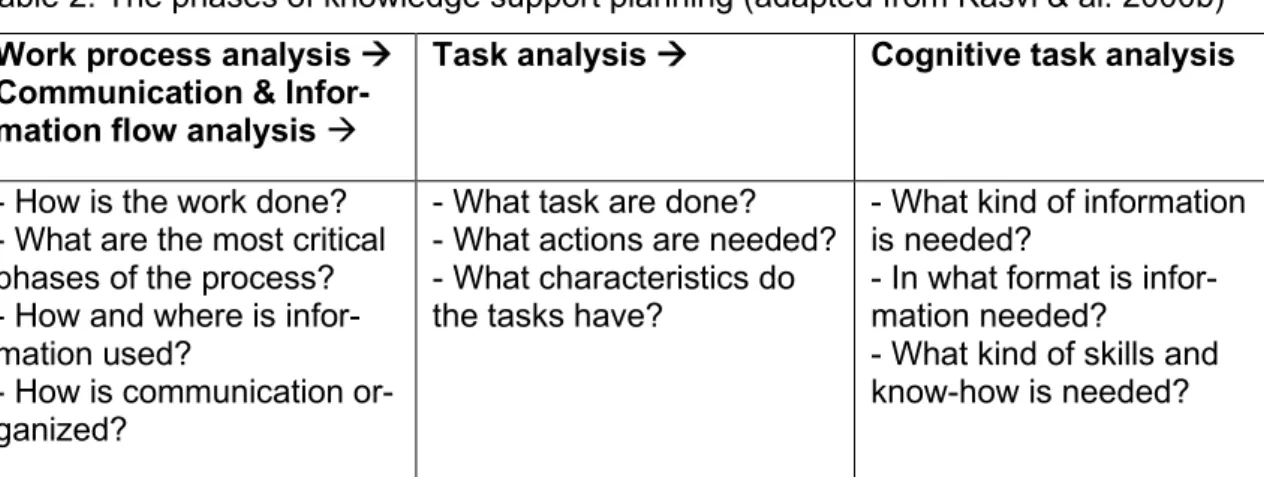
Approach and methods
When the necessary changes were made, the next stage was to actually conduct the research. The case study approach often also combines many different types of methods to obtain the most versatile material for the research object. In qualitative research the material is also mainly collected in interaction with the research subjects, and the point is to pay attention to their views and understandings of the situation.
Data collection
Document analysis
In order to find answers to these questions, the current situation at Airline X OCC was reviewed and analyzed by inspecting various written documents and tools that were part of the identified knowledge management and knowledge support infrastructure in the studied organization. The second aspect was to analyze the knowledge sources, knowledge repositories and distribution channels in order to get a better overview of the current knowledge supporting tools and means. All in all, the document analysis was a fairly time-consuming process that started in January 2021 with a systematic review of the processes, communication methods and knowledge sources, repositories and distribution channels used in the department, as well as a close reading of the documents.
Focus group discussion
Three of the participants were at Airline X office, while two of them joined the discussion virtually. The discussion was documented by taking notes and the notes were reviewed together at the end of the session to ensure that there was a mutual understanding of the outcome, and to ensure that everything was registered. The notes were then further analyzed and reported by the researcher quite promptly after the session in May 2021, while the discussion was still fresh in mind.
Interviewing
The interviews were conducted during the latter part of May 2021 after the document analysis and the focus group discussion. This is also why the directed qualitative content analysis was used in this study where the themes, i.e. the coding structure, used in the content analysis were derived from the knowledge management theory. The focus group discussion session and the interviews were also analyzed using content analysis so that the relevant meaning could be better identified.
Document analysis
Processes
The main processes of Airline X OCC, and the sub-processes and task instructions defined in the Operational Control Manual in relation to the main processes, are described in the. The designated responsible persons for the processes are also marked (RP1, RP2, RP3) in the table, when they are mentioned in the manual. On the other hand, for example, the main process "Operational Control" has no defined principles or sub-processes whatsoever in the Operational Control Manual.
Communication
Some of the communication practices are defined very specifically (for example Workplace Conferences and Daily Conferences), while others are mentioned only briefly (for example SMS) or. Additionally, connections to some of the communication systems are provided (for example Opsmetrics) while others are not (for example ACARS). Some of the information provided about communication methods and practices is also outdated or incomplete.
Knowledge sources, repositories, and distribution channels
Some of the methods mentioned (for example Outlook calendar and OCC Whiteboard) are, on the other hand, not mentioned at all in the practices. In order to analyze the identified knowledge sources and knowledge repositories and distribution channels, the strengths and weaknesses of the tools were examined. The analysis of the knowledge stores and distribution channels showed that many of the systems apparently had a weak discoverability.
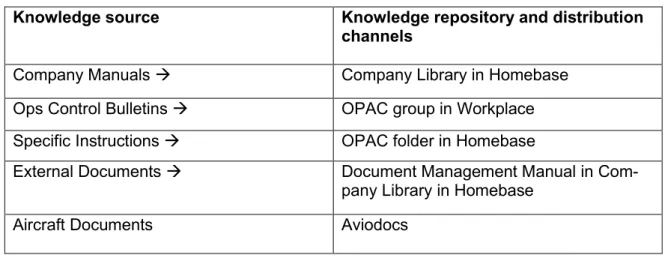
Focus group discussion
When the discussion continued with the goals of the development process, the group discussed the most important aspects regarding a knowledge support and listed points that must be fulfilled in an ideal solution. However, the group agreed that none of the existing solutions had all the features required for good usability from the OCC's point of view. After this, the group said that the next step should be to further define the structure of the instructions, so that they will have a solid form that will improve findability, memorability and efficiency.
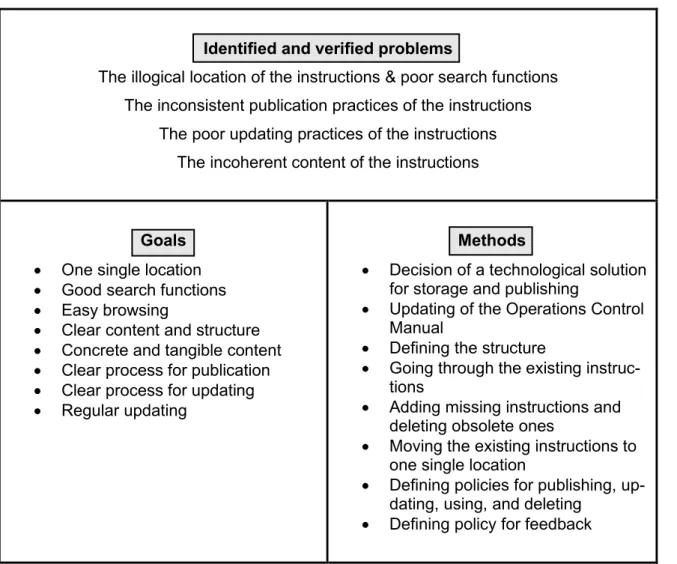
Interviews
Sharing of knowledge
Some also felt that the social connections affected knowledge sharing in some cases and that the knowledge flow depended on who was on the shift. It is likely that people will not share something without asking, because they think that others already know." Maybe also that the service managers will then check it and verify if it is a way that can also be used in the future.".
Capturing of knowledge
The supervisors often have divergent views on what we should know and what skills we should possess. It would be good if the supervisors would collect it, as they then have the opportunity to share it with everyone”. One way to get information about our real knowledge needs is for the shift managers to work with us.
Processing of knowledge
I would rather fix the system so that the information is aggregated somewhat more sensibly. Maybe if it was possible to click and try it in a peaceful environment…”. A test environment would certainly be brilliant so you can try it out for yourself.”
Summary of the findings
In terms of the usability of the knowledge repositories and distribution channels, the findings showed that many of the systems were difficult to find and only a few of them were interactive or individualizable. The analysis of the knowledge sources, repositories and distribution channels also generally revealed many inconsistencies. The usability of the existing repositories and distribution channels was not considered sufficient by OCC.
Conclusions and development ideas
To solve knowledge support problems, both work processes and tasks, and knowledge management processes and responsible persons must first be clearly defined and also clearly stated and communicated throughout the organization. This is something to think about more closely as sharing and capturing are also generally considered to be the most important knowledge management processes (see chapter 2.2.1). Moreover, to ensure efficient, consistent and high-quality performance, effective knowledge processing should also be promoted.
Reflections on the research process and the credibility of the study
Also, the representation of the findings related to the studied phenomena was taken into consideration. This also minimized acceptance bias, i.e., the tendency to agree or be positive about whatever is proposed, which could have occurred in verifying the results if the respondents were not sufficiently interested in the topic. On the other hand, the interviewees were chosen randomly, as the goal was to obtain data that would represent as accurately as possible the perceptions of all departments, and not just the opinions of specialists. The interviewees were all OCC employees, which leads to a narrower picture about the culture of knowing what could have been achieved if also.



